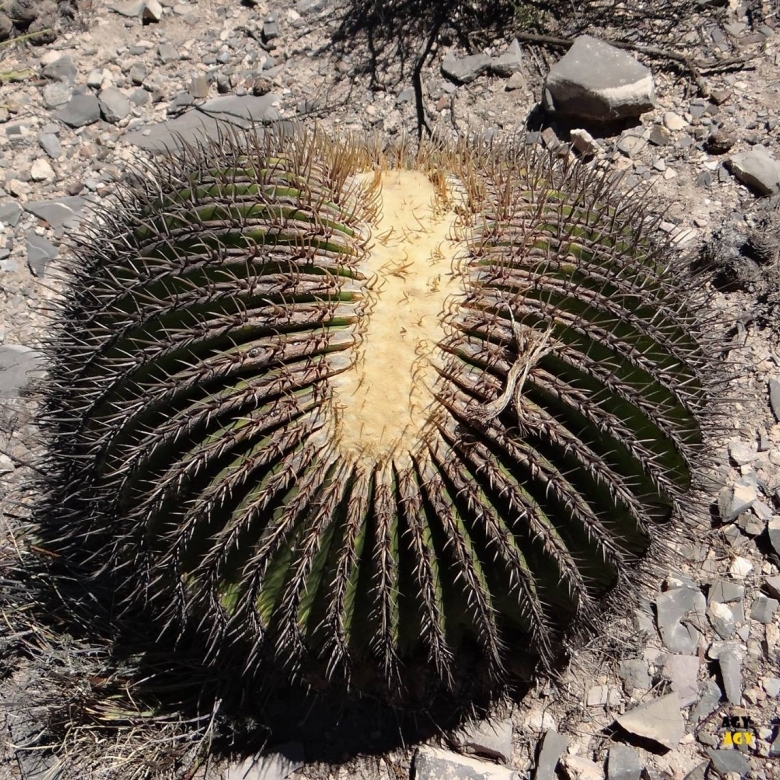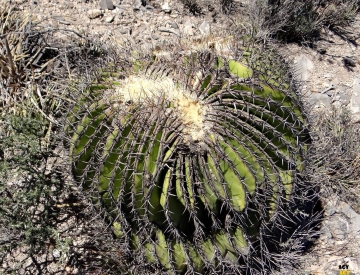




Your support is critical to our success.
Accepted Scientific Name: Echinocactus platyacanthus Link & Otto
Verh. Vereins Beford. Gartenbaues Konigl. Preuss. Staaten 3: 423. T. 14. 1826 (1827)

A natural occurring crested specimen in mexico.
Origin and Habitat: Echinocactus platyacanthusSN|10367]]SN|10367]] is endemic to Mexico, is widely distributed in the southern half of the Chihuahuan Desert within Coahuila, Guanajuato, Hidalgo, Nuevo León, Querétaro, San Luis Potosí, Tamaulipas and Zacatecas. It is also distributed in the southern Tehuacán Valley in Puebla and Oaxaca, where it is relatively common. Though these crested Echinocactus platyacanthusSN|10367]]SN|10367]] are somewhat rare, cresting occurs naturally throughout the range of the species, and can be encountered in many other cactus species.
Synonyms:
Echinocactus platyacanthus Link & Otto
Verh. Vereins Beford. Gartenbaues Konigl. Preuss. Staaten 3: 423. T. 14. 1826 (1827)
Synonymy: 22
- Echinocactus platyacanthus Link & Otto
- Echinocactus ingens Zucc. ex Pfeiff.
- Echinocactus ingens f. aulocogonus (Lem.) Schelle
- Echinocactus ingens var. helophorus (Lem.) K.Schum.
- Echinocactus helophorus Lem.
- Echinocactus ingens f. helophorus (Lem.) Schelle
- Echinocactus ingens var. saltillensis (hort.) K.Schum.
- Echinocactus ingens f. saltillensis (Poselg.) Schelle
- Echinocactus saltillensis hort. non Poselg.
- Echinocactus ingens var. subinermis K.Schum.
- Echinocactus ingens var. viznaga (Hook.) K.Schum.
- Echinocactus karwinskii Zucc. ex Pfeiff.
- Echinocactus platyacanthus f. cristata hort.
- Echinocactus platyacanthus f. grandis (Rose) Bravo
- Echinocactus grandis Rose
- Echinocactus ingens var. grandis (Rose) Krainz
- Echinocactus platyacanthus var. palmeri (Rose) H.P.Kelsey & Dayton
- Echinocactus palmeri Rose
- Echinocactus platyacanthus var. viznaga (Hook.) W.T.Marshall
- Echinocactus ingens f. viznaga (Hook.) Voss in Vilm.
- Echinocactus viznaga Hook.
Description: The standard visnaga, Echinocactus platyacanthusSN|31320]]SN|10367]], is a slowly growing barrel cactus known under popular name visnaga, it is usually solitary and grows huge in habitat. It could live more than a hundred years and is easily recognized because of its massive size, by far the largest of all barrel cacti. In nature Echinocactus platyacanthusSN|10367]]SN|10367]] has produced some extraordinary fan or twisting crested forms. These beautiful crested forms (Echinocactus platyacanthus f. cristataSN|10367]]SN|31320]]) are very rare in collection and highly priced for their sculptural shape and size. Older crested plant grown outdoor in the ground (in mild areas) can reach an imposing size (up to 1, or more, m tall weighing several hundreds kilograms). Flowers are produced only on the the apex of adult crested stems. In cultivation crested specimens are often grafted on stronger species, called the stock, that can be any number of different columnar cactus. The stem is grey-blue heavily ribbed with numerous areoles forming a continuous line. They are day-flowering plants with vivid yellow flowers produced in spring and summer-autumn.
More...Subspecies, varieties, forms and cultivars of plants belonging to the Echinocactus platyacanthus group
 Echinocactus ingens Zucc. ex Pfeiff.: (same as E. platyacanthus)
Echinocactus ingens Zucc. ex Pfeiff.: (same as E. platyacanthus) Echinocactus platyacanthus Link & Otto: This is the largest of all barrel cacti, it is grey-blue and nice when small, but areoles merge and forms a continuous line when it became large.
Echinocactus platyacanthus Link & Otto: This is the largest of all barrel cacti, it is grey-blue and nice when small, but areoles merge and forms a continuous line when it became large. Echinocactus platyacanthus f. cristata hort.: crested form.
Echinocactus platyacanthus f. cristata hort.: crested form. Echinocactus platyacanthus f. grandis (Rose) Bravo: This is one of the very large species of Echinocactus and is very characteristic of the deserts of Puebla where it is often the conspicuous plant of the landscape.
Echinocactus platyacanthus f. grandis (Rose) Bravo: This is one of the very large species of Echinocactus and is very characteristic of the deserts of Puebla where it is often the conspicuous plant of the landscape. Echinocactus platyacanthus var. viznaga (Hook.) W.T.Marshall: (same as E. platyacanthus)
Echinocactus platyacanthus var. viznaga (Hook.) W.T.Marshall: (same as E. platyacanthus)
Bibliography: Major references and further lectures
1) Edward Anderson “The Cactus family” Timber Press, Incorporated, 2001
2) James Cullen, Sabina G. Knees, H. Suzanne Cubey "The European Garden Flora Flowering Plants: A Manual for the Identification of Plants Cultivated in Europe, Both Out-of-Doors and Under Glass" Cambridge University Press, 11/Aug/2011
3) David R Hunt; Nigel P Taylor; Graham Charles; International Cactaceae Systematics Group. "The New Cactus Lexicon" dh books, 2006
4) N. L. Britton, J. N. Rose “The Cactaceae. Descriptions and Illustrations of Plants of the Cactus Family.” Volume 4, The Carnegie Institution of Washington, Washington 1923
5) Curt Backeberg “Die Cactaceae: Handbuch der Kakteenkunde” Gustav Fischer Verlag, Stuttgart New York 1982–1985
6) Hernández, H.M., Cházaro, M. & Gómez-Hinostrosa, C. 2013. Echinocactus platyacanthus. The IUCN Red List of Threatened Species. Version 2014.3. <www.iucnredlist.org>. Downloaded on 31 May 2015.
7) F. Baluska, Milada Ciamporová, Otília Gasparíková, Peter W. Barlow “Structure and Function of Roots: Proceedings of the Fourth International Symposium on Structure and Function of Roots”, June 20–26, 1993, Stará Lesná, Slovakia Springer Science & Business Media, 11 Nov 2013
8) Kishan Gopal Ramawat “Desert Plants: Biology and Biotechnology” Springer Science & Business Media, 16 Dec 2009
9) Park S. Nobel “Environmental Biology of Agaves and Cacti” Cambridge University Press, 16 October 2003
10) Hiroshi Hirao “Colour encyclopaedia of cacti” Japan 1979 (Japanese language and script)
11) Willy Cullmann; Gerhard Groner; Erich Gotz “The Encyclopedia of Cacti” Alpha Books 1986
12) Del Castillo, R., and S. Trujillo. 1991 “Ethnobotany of Ferocactus histrix and Echinocactus platyacanthus(Cactaceae) in the semiarid Central Mexico: Past, present and future.” Economic Botany 41: 495-502.

The growing line with small flowering buds. Photo by: Agócs György

Crested habit. Mexico. Photo by: Agócs György
Cultivation and Propagation: Visnagas (Echinocactus platyacanthusSN|10367]]SN|10367]]) grow very slowly and are cold intolerant. Make sure that your visnaga are not exposed to freezing temperatures, or they may die. The plant needs a well drained soil mix. Water regularly in summer, but allow to dry fully before watering again. During the winter months they should be rather kept dry. Since they are big sized plants, they need plenty of space for their roots. Repotting should be done every other year, or when the plant has outgrown its pot.
Exposure: Light shade when young, full sun later.
Crested growth: Unlike 'monstrose' varieties of plants, where the variation from normal growth is due to genetic mutation, crested growth can occur on normal plants. Sometimes it's due to variances in light intensity, or damage, but generally the causes are unknown.
Propagation: Grafting or cuttings. Plants are usually grafted onto column-shaped cacti but proved to be able to produce their own roots if degrafted. Cuttings will take root in a minimum temperature of 20° C (but better in hot weather). Cuttings can be taken in the spring and summer. Cut the stem with a sharp, sterile knife, leave the cutting in a warm, dry place for a week or weeks (depending on how thick the cutting is) until a callus forms over the wound. Once the callus forms, the cutting may be inserted in a container filled with firmed cactus potting mix topped with a surface layer of coarse grit. They should be placed in the coarse grit only; this prevents the cut end from becoming too wet and allows the roots to penetrate the rich compost underneath. The cuttings should root in 2 to 6 weeks. Large crested piece must be placed on the soil surface without burying the plant base down in the soil.
Collapse...
| Your Actions | |
|---|---|
| Back to Echinocactus index | |
| Back to Cactaceae index | |
 |
Back to Cacti Encyclopedia index |
Privacy stantement - Terms and conditions - How to cite - About us - Feedback - Donate



